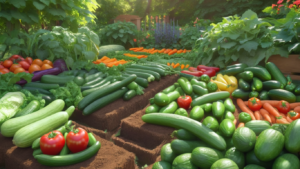Planting the Garden

Before you scroll, check out this garden savings.Save 50.0% on select products from Lovawing with promo code 502DE7SD, through 5/5 while supplies last.
Introduction to Gardening
Gardening is more than just a hobby; it’s a therapeutic activity that brings joy and satisfaction to many. Whether you’re a seasoned gardener or a beginner with a green thumb, planting your garden can be a rewarding experience. Not only does it beautify your surroundings, but it also provides you with fresh produce and a connection to nature.
Choosing the Right Location
Before you start digging, it’s essential to assess your garden’s location. Choose a spot that receives adequate sunlight, preferably six to eight hours a day, as most plants thrive in sunlight. Additionally, ensure that the soil is fertile and well-draining, as soggy soil can lead to root rot. Accessibility to a water source is also crucial for easy maintenance.
Selecting Plants
Understanding your region’s climate is vital when selecting plants for your garden. Choose plants that are well-suited to your local climate and soil conditions. Consider factors such as temperature, rainfall, and frost dates to ensure the success of your garden.
Preparing the Soil
Preparing the soil is the foundation of a healthy garden. Start by clearing the area of any debris, rocks, or weeds. Then, enrich the soil with organic matter such as compost or well-rotted manure to improve its texture and fertility.
Creating a Planting Plan
A well-thought-out planting plan is essential for maximizing space and ensuring proper growth. Organize your plants based on their growth habits, placing taller plants at the back and shorter ones in the front. Consider spacing requirements to prevent overcrowding and competition for resources.
Planting Seeds or Seedlings
Whether you’re planting seeds or seedlings, proper technique is crucial for success. Plant seeds at the appropriate depth and spacing, following the instructions on the seed packet. When transplanting seedlings, handle them carefully to avoid damaging the roots, and water them thoroughly after planting.
Watering Techniques
Watering is one of the most critical aspects of garden care. Understand the watering needs of your plants, as different species have varying requirements. Water deeply and infrequently to encourage deep root growth, and avoid watering during the hottest part of the day to prevent evaporation.
Mulching for Moisture Retention
Mulching is an effective way to conserve moisture in the soil and suppress weed growth. Apply a layer of organic mulch, such as shredded bark or straw, around your plants to retain moisture and regulate soil temperature. Mulching also adds nutrients to the soil as it breaks down over time.
Weeding and Pest Control
Regular maintenance is essential to keep your garden healthy and thriving. Take the time to weed regularly to prevent weeds from competing with your plants for nutrients and water. Implement natural pest control methods such as companion planting and introducing beneficial insects to keep pests at bay.
Pruning and Maintenance
Pruning is necessary to promote healthy growth and maintain the shape of your plants. Remove dead or diseased branches, and prune back overgrown foliage to encourage new growth. Regularly inspect your plants for signs of pests or disease, and take prompt action to prevent spread.
Fertilizing for Growth
Fertilizing provides your plants with essential nutrients to support growth and development. Choose a fertilizer that is appropriate for your plants’ needs, whether it’s a balanced fertilizer for general feeding or a specialized formula for specific plants. Apply fertilizer according to the manufacturer’s instructions to avoid overfeeding.
Monitoring and Adjusting
Keep a close eye on your garden and monitor the health of your plants regularly. Look for signs of nutrient deficiencies, pest infestations, or other issues, and make adjustments as needed. It’s essential to be proactive in addressing problems to prevent them from escalating.
Harvesting Your Garden
One of the most rewarding aspects of gardening is harvesting the fruits of your labor. Knowing when to harvest is crucial, as it ensures that your produce is at its peak flavor and freshness. Use sharp garden shears to harvest fruits and vegetables, and handle them carefully to avoid bruising.
Enjoying the Fruits of Your Labor
There’s nothing quite like the satisfaction of enjoying homegrown produce straight from your garden. Whether it’s crisp lettuce, juicy tomatoes, or sweet berries, savor the flavors of your labor. Share your bounty with friends and family, spreading the joy of gardening to others.
Conclusion
Planting your garden is a fulfilling journey that rewards patience, dedication, and care. By following these steps and nurturing your plants with love, you can create a beautiful and bountiful garden that brings joy and sustenance for years to come.
FAQs
- How much sunlight do most plants need? Most plants thrive in six to eight hours of sunlight per day, although some may require more or less depending on their species.
- What is the importance of mulching? Mulching helps retain moisture in the soil, suppress weed growth, and add nutrients as it breaks down over time.
- How often should I water my garden? Watering frequency depends on factors such as plant type, soil conditions, and weather. Generally, it’s best to water deeply and infrequently to encourage deep root growth.
- What are some natural pest control methods? Companion planting, introducing beneficial insects, and using organic pesticides are all effective natural pest control methods.
- When is the best time to harvest fruits and vegetables? Harvest fruits and vegetables when they are ripe and at their peak flavor and freshness. Use sharp garden shears to avoid damaging the plants.